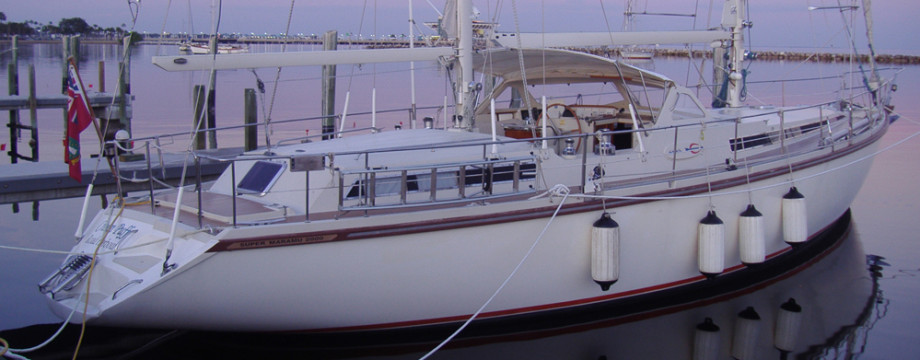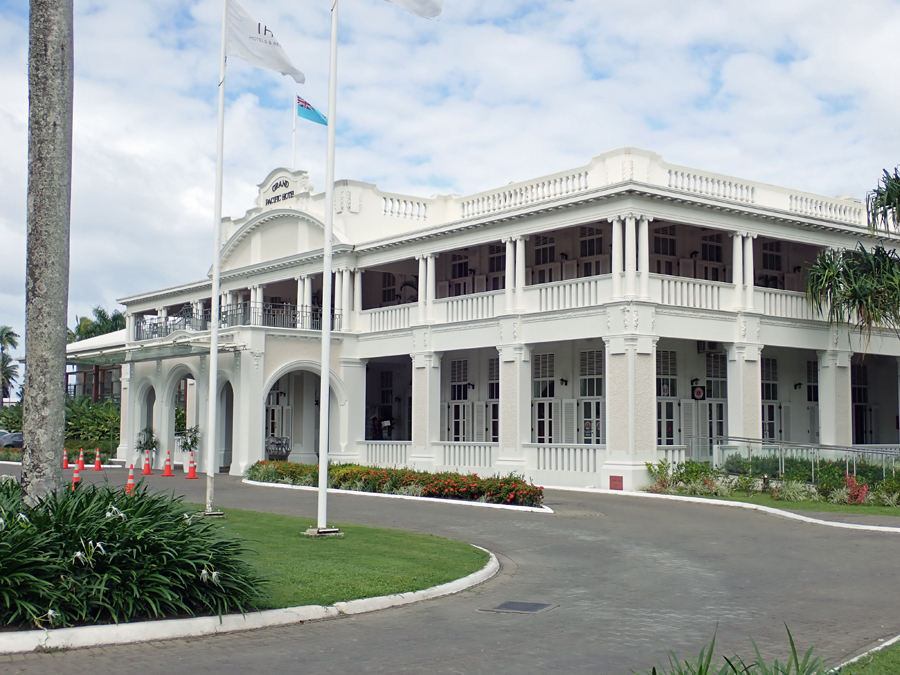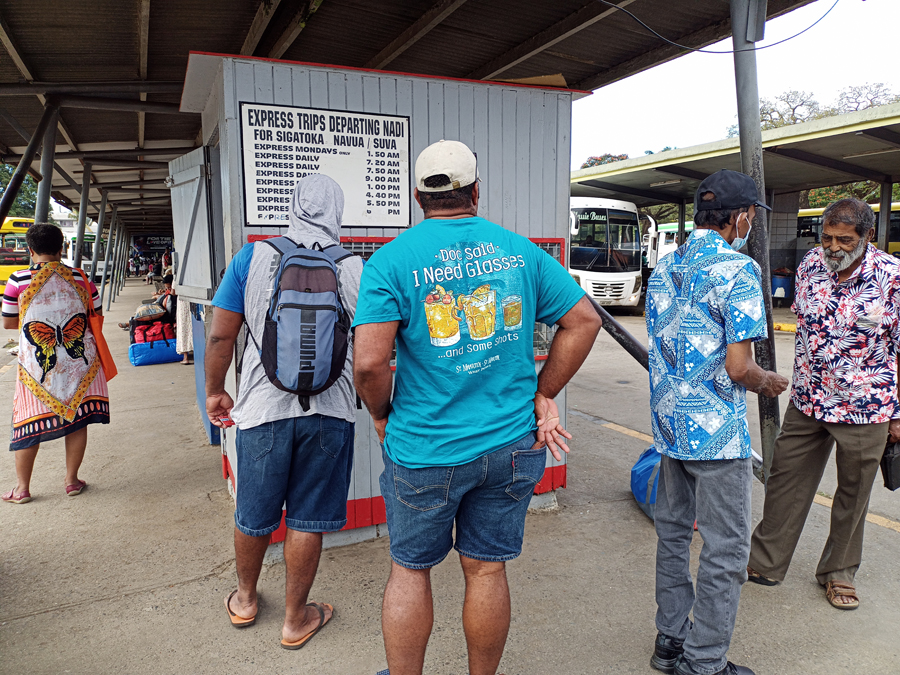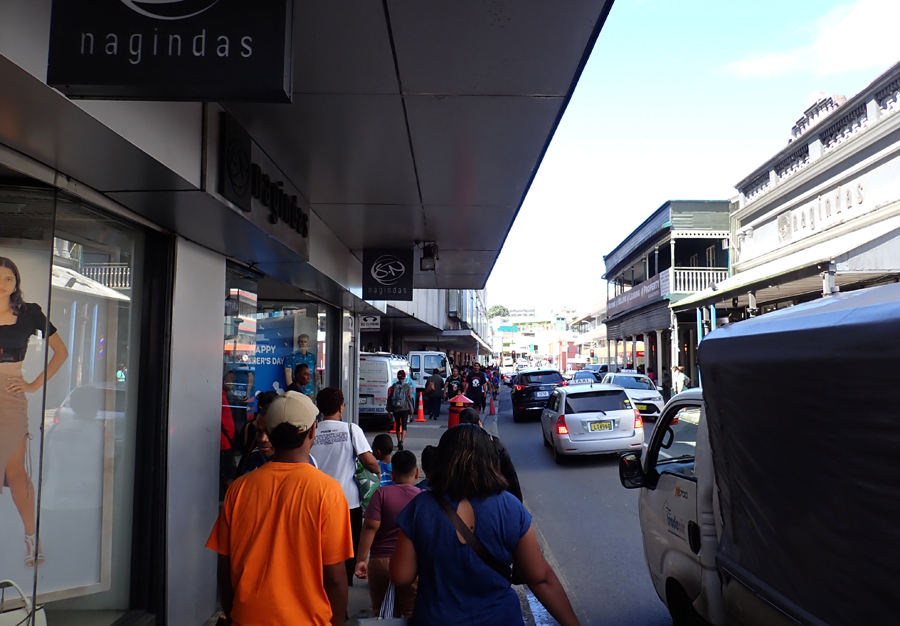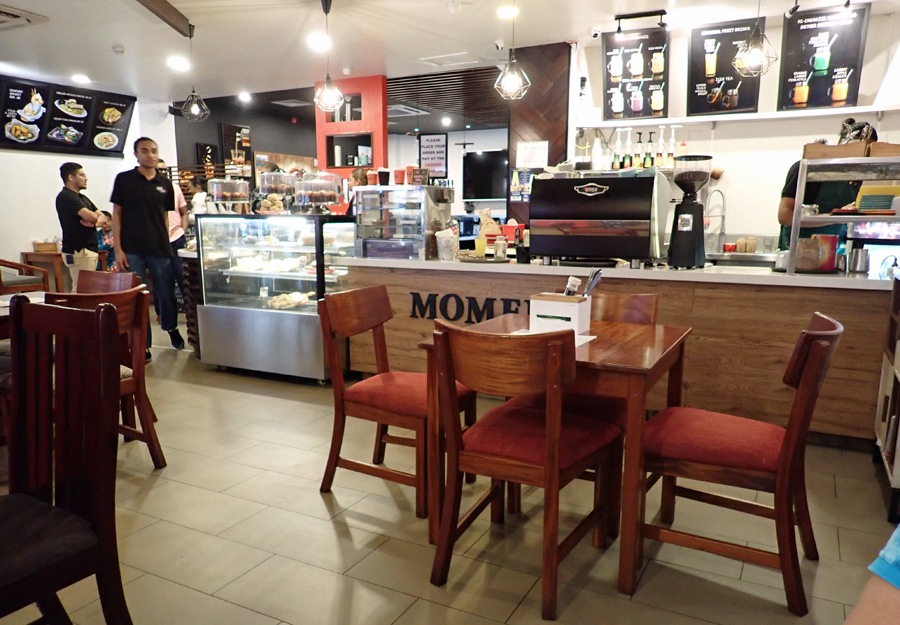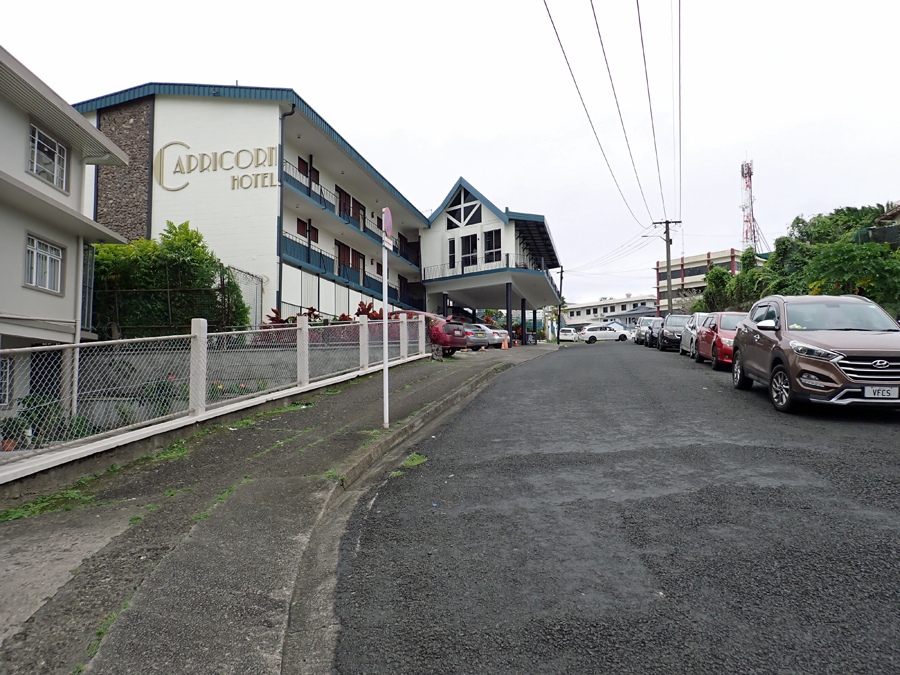We decided to go to Suva, the capital city of Fiji. Over the weekend, we talked to a couple of local people and mentioned we are heading to Suva. Our hope was they’d share some insight about what to see and do there. We both were a little surprised when we announced our intentions and were met with the single-word response, “Why?”
I explained, well it’s there and we’re here. It kinda makes sense, don’t ya think? This still didn’t yield any positive vibes. Instead, we were told to be careful. Don’t go out at night and it’s a really long way away. I guess if you live on the island and take a trip to the other side, it must feel like a long way away. In truth, it’s a 4-hour bus ride. Perhaps, 3.5 hours by car.
This trip was a bit impulsive. So, our options of places to stay were limited. Normally, our choice would be to rent a small house or apartment. After checking the big two, not much was available, and absolutely nothing was available in the downtown area. We like to stay in town so we can walk the area attractions rather than taxi or try to figure out yet another bus system.
Cindy found us a room at a 5-star hotel. I found us a choice at a 3-star fleapit. After some convincing, I “sold” Cindy on the cheaper hotel. I did this knowing it was a bit of a risk and that I’d be in the doghouse if it truly turned out to be a fleapit. Here is how this went down.
I found a hotel called the Capricorn Hotel on Google Maps. The past few recent reviews all raved about the hotel. They all spoke of a recent renovation and ideal location. The hotel is in the heart of the city, but on a dead-end side street, meaning no traffic noise. It is a short walk from the bus station and although the hotel had no restaurant, several are located very nearby. The rooms have a small cooktop, refrigerator, microwave, dishes, pots, pans, etc. Sort of an apartment setup. The best part is we can stay three nights for a total of US$245.84 or $81.94 per night (75.75€). I’m sold! I show Cindy the pictures and my excitement about the value must have been contagious (he says sarcastically). Cindy is one click away from booking her 5-star luxury hotel but I managed to beat her to it.
This is when Cindy started to read the reviews on TripAdvisor for my booking. They’re not great. In fact, most of them are terrifying. They mention bedbugs, an angry Indian woman who manages the front desk, dirty horrible rundown rooms, and filth. One review simply just said, “Run and don’t look back”. Normally you would have lost me at bedbugs. In my previous life, I traveled an awful lot and tried to stay one step ahead of bedbugs.
My understanding of bedbugs is once they get on you, your clothes, or your luggage, you then carry them home and they are impossible to get rid of. The only way to get rid of them is to throw things away. Once in a while in New York City, I’d see a sofa on the street with a sign that said bedbugs. Or, the sofa would be spray painted with the word “bugs”. New Yorkers stayed well clear of it. For a New Yorker not to take a free item on the street speaks volumes to the joy bedbugs yield.
Which review site is going to be right? Will it be Google Maps or TripAdvisor? Will I save a few dollars and be crowned with this year’s Ultimate Cheapskate award? Or, will I be in the doghouse? Keep reading.
We figured out the bus schedule from Nadi to Suva. We’re looking for an express bus. The Pacific Bus company web page had the schedule and fare. It had all sorts of great information about the buses. I now know the horsepower of the engine, the fact it is a diesel pusher, has large dust-free luggage compartments, a WABCO ABS breaking system, air conditioning, dark tinted windows with blue curtains, Luxury seats (2 + 2 layouts) in weft knitted fabric, adjustable seat back, side-sliding mechanism, arm rests, foot rests, three-point-safety seat belts and a magazine net in front of your seat. I now know everything I need to know about these buses except where and how to buy a ticket.
Nowhere on the website does it mention anything about purchasing a ticket. It has the fares (more on this later). This is a little concerning since we’ve read some buses don’t take cash. Is this one of those? We stop by the office of the marina and start to ask questions. This is one of the nice perks of staying in a marina. The staff here are awesome and are happy to help. They explain there is a ticket booth at the bus station and you don’t need a reservation. They think Pacific Buses take cash but they didn’t in the past. We’re told to get there a little bit early just in case. It’s Fiji, there is no way they’ll leave a potential passenger behind because they don’t have the correct payment method. Don’t worry, we are told, they’ll put you on the bus. One way or another, you’ll be on the bus.
On the day of our big extravaganza to Suva we make an early start. We need to be in Nadi by 08:30 to catch a 09:00 bus. Our first step is the yellow bus from Denarau to Nadi. By car, this is less than a 15-minute trip, about 7.5 km (4.4 miles). By bus, pretty much anything can happen. If the bus is full, it won’t stop. Sometimes the buses get out of whack. We might wait 40 minutes for one and then three come along in the next 5 minutes. There doesn’t seem to be a schedule. We decide to be at the bus stop at 07:30.
We wait for 30 minutes at the bus stop. Not to worry, we’ve given ourselves plenty of time. And then, eureka, a yellow bus comes around the corner. A lot of people get off so there’s plenty of room. The bus makes the rounds to the various resort hotels and at this point most people are off the bus as they are going to work. There are only four of us as we leave Denarau. Cindy optimistically says, looks like it’ll be a short ride with few stops. I’m going to blame her for this first jinx.
We pick up a few school kids. They will flag the bus down at the end of their driveway. Sometimes this means the bus will stop at driveways just a few meters apart. We are barreling down the road, and then all of a sudden, it goes quiet. I look at Cindy and say, the engine just died. The bus starts to coast. The driver is frantically trying to restart the engine with the key while looking for a safe spot to pull over.
He jump-starts the bus by popping the clutch while in gear. This means everyone gets a case of whiplash. The engine starts. Yay! We make it a little further down the road. Kids are at the next bus stop. Is the driver going to risk stopping? He does. And, while he is stopped he keeps revving the engine to make sure it doesn’t die. Off we go. But, not far. The engine dies again. This time we coast to a red light. The driver takes the far left lane which is a turn lane even though we need to go straight. I assume he did this so he wouldn’t block the road. He doesn’t have much faith that the bus will start.
The light turns green, everyone except us moves forward. The driver keeps cranking the engine. For the first time since we started this morning, I fear we’ll not make it to Nadi in time for our next bus. The schoolchildren start to move toward the forward seats. Yep! They’ve done this before. They’re formulating an escape plan so they can get to school on time. I’m wondering if we can get a cab. Remarkably, the engine starts again.
For the next few miles, the bus driver does an amazing job of keeping the engine running. We can tell the engine wants to die. It coughs and sputters. The driver pumps the gas pedal. I can’t believe it but he makes it to the school, drops off the kids, and even manages the roundabout at the outskirts of Nadi. We make a couple of turns, we pass the clinic and the engine at this point really is struggling. There is one more light and then we are home free at the bus station. There is another yellow bus dead on the side of the street. This must be the place where all yellow buses come to die. Our bus decided to die here as well.
At this point, we are less than a block away from the bus depot. I can hear the driver yelling into his cell phone. I’m guessing it was not fun for the person at the other end especially if they were the mechanic. I don’t think the bus is going any further. Taking a page from the school kids’ playbook, we think we should look for an escape plan. We can easily walk from here. The words “let’s walk” were right on the tip of 0ur tongues when the engine started again. Unbelievable! This bus still has life left in it.
The bus driver, still yelling into his phone, quickly gets into gear. He runs the red light and makes the final turn to the bus depot. The bus dies again as he coasts into his parking place. As we paid our fare, just FJ$3 (US$1.30 or 1.23€), total fare for both of us, I can’t help but think if they charged a little bit more they could fix the bus properly.
We arrive at the bus depot with plenty of time to catch our express bus to Suva. So far, things have gone pretty well, don’t ya think?
The ticket booth that sells tickets for the Pacific Bus (much to the surprise of their web page designer) is easily spotted. I start with pleasantries. We have learned in our travels to show some respect before asking for anything. I am having a little bit of trouble hearing the guy in the cage through the small hole in the Plexiglas window because of the buses around me. He steps to the side and this places him just outside of the booth and we can now talk face to face. I ask for the tickets to Suva and hand him the fare that was posted on the internet site, FJ$14.60 each. I give him FJ$30.00. He looks at me like I’m from Mars.
He tells me the fare is FJ$22.00 each. I explain I got the fare amount from the internet site. This brings a roar of laughter. “Perhaps that was the fare in 1980 but today it is FJ$22.” No problem. I pull out a crisp blue $50 note. Now there is a problem. He doesn’t have change. I start to think and wonder how a ticket booth selling bus tickets (much to the dismay of the internet site designer) doesn’t have any change. Standing there, I don’t say anything. I have learned in Fiji to stay quiet and things sorta work out.
It turns out the bus system uses Vodafone tap cards. They don’t take major credit cards. My guess is the credit card merchant fees are higher than Vodafone. Vodafone is known as a cell provider. However, in Fiji they seem to have a business with tap cards. We have seen signs all over the place for Vodafone top-offs. Now I know what these are for. Just stop at a top-off place, pay some cash they charge your card immediately. They are like debit cards but no need for a bank. And, we don’t have one of their cards.
The guy at the ticket booth gives me his card. He points me toward the nearest Vodafone booth just a few steps away. Also, he tells me to give the person my $50 Fiji bill and ask for $44 to be put on the card. He says not to worry, they’ll know what to do. Then, bring him back the card and the receipt. I tell Cindy to wait with our duffel bag and backpacks while I go to the booth. The lady in the booth knows what to do. I am handed the newly charged Vodafone card, my change, and my receipt. I head back to the Pacific ticket booth and the waiting and wondering Cindy.
I return the card to the guy in the booth, he taps it on his machine and gives me two FJ$22 tickets. He tells us to make sure we keep the tickets as they check them on the bus more than once. He is very busy with other passengers but takes time to make sure we are fully taken care of. Once things slow down a little bit, I ask him about the card and if I should get one so I can buy a return ticket in Suva.
The Vodafone cards cost about FJ$10 each. He explains all conductors will have a spare card to use as he did. It is easier if I have the correct fare so they don’t need to mess with any change. I laugh and say, the company needs to update the web page. When I look at the page again a little bit closer, I see it states the posted fares are from October 2017.
Our bus arrives right on time and departs almost to the exact minute of the scheduled time. In addition to the prices on the site being very outdated, the information on the buses was also old. Although somewhat clean and comfortable, the bus is far from new. I think the information about “new” buses was of the same vintage as the published prices. Regardless of the new price, the trip to Suva is very inexpensive. The total roundtrip fare for both of us was FJ$88.00 (US$38.80 or 36€).
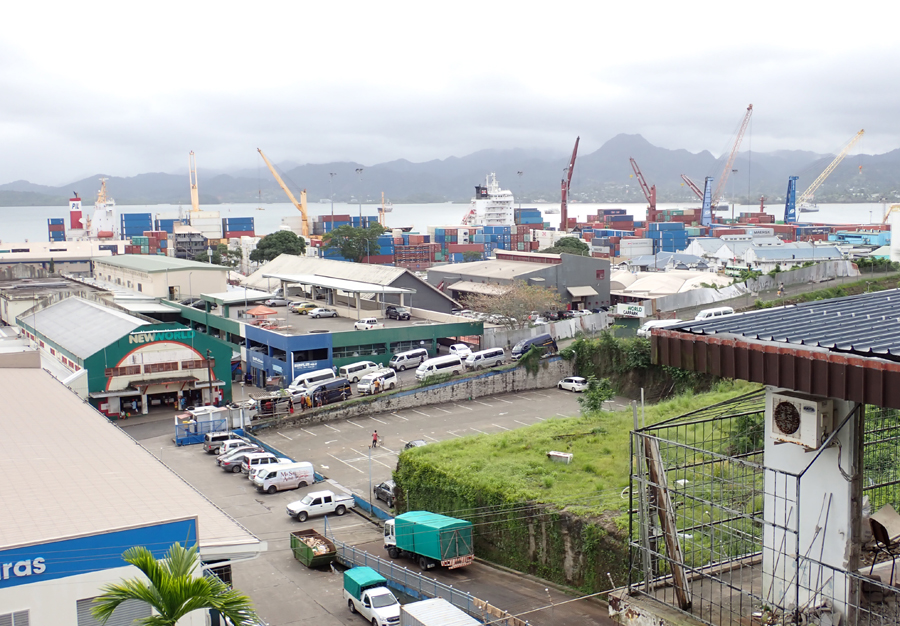
A glimpse of Suva’s main port from the hotel. We saw a lot of freighters come and go during out short stay there
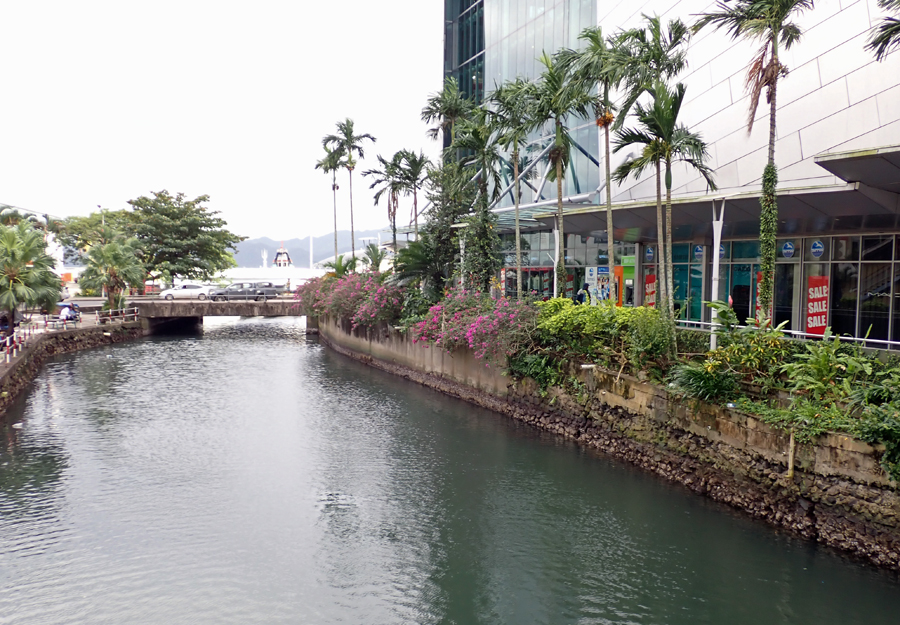
Nabukalou Creek Bridge offers a nice view. In the background is Suva’s flagship department store, Tappoo. It is 6 stories.
About 4 hours later, we step off the bus at the Suva bus depot. My immediate feeling of Suva is wow, so many people. We have really gotten used to the relaxed atmosphere on Denarau Island. It’s also kind of strange to see people wearing business clothes. Being in a tourist destination for the past couple of months we’ve quickly gotten used to seeing people in their holiday outfits.
Suva is hilly. It is a port town and walking along the waterfront is about the only flat ground. The moment a person steps inland they are faced with hills. We quickly found that because of the hills and a river, the streets aren’t laid out in a grid. We plot out our hotel on Google Maps and begin the short walk. All the time I am wondering what lies ahead when we reach the hotel. Will we be pleasantly surprised or immediately shopping for an alternative place to stay?
We’re both hungry. There were “No Food or Drink” signs on the bus but these were ignored by everyone. Cindy is the planner and had the foresight to pack a couple of power bars for us to snack on during the trip. Most people grabbed food at one of the stops. The bus depots at Sigatoka and Pacific Harbour have a lot of street food vendors. A good majority of the passengers got off to grab a snack. To be perfectly honest, I was a little bit afraid of getting off the bus since I envisioned us returning only to find the bus gone. Cindy previously scouted out a café near the hotel and this was our first destination.
We arrive at Moment’s Café. It is packed. A good sign. The food is really good and things are starting to look up. The wacky yellow bus adventure seems like it was yesterday. We relax a little bit and take our time over a nice lunch. I expected the prices to be a little bit higher in Suva since this is where a good majority of Fiji’s population lives. However, the prices are really reasonable and the food is tasty.
The Capricorn Hotel is uphill. Climbing the hill with backpacks and a duffle was a cardiac workout. I am convinced my calf muscles are going to explode. We both make it to the lobby and wait as a family ahead of us checks in. They were lucky. They had a car. We patiently wait while the heart rate slows, the calves sigh with relief and we take in the décor of the lobby. So far, so good.
After the front desk formalities, the receptionist shows us to the room. I thought this to be a nice touch rather than just point the way. With her she brings the remote controls for the television and the air conditioner. This strikes me as a little strange. I wonder how many people stole these that now the policy of the hotel is to keep them secure. Our room is up one flight of stairs. There is no lift (elevator) but we are recuperated enough now to handle this.
Entering the room, we are pleasantly surprised. Everything is new-ish. It is clean. Well, cleanish. I have stayed in Marriotts and Hiltons not as clean as this hotel. So, this will do nicely. We pull back the sheets to check for bedbugs. The mattress is new as are the duvet and sheets. There are no bedbugs. The room turns out to be really quiet since the hotel is cinderblock concrete construction. In our conversation with the manager later during our stay, we are informed the hotel has gone through a series of three renovations in the past couple of years. The last is still going on with the addition of a small restaurant and an updated conference room.
Next up in part 2, we go up and down the hills of Suva and try to meet the president.
